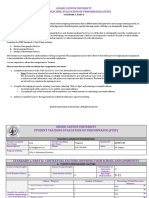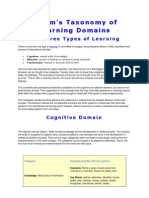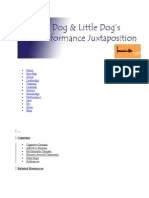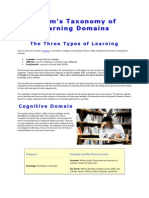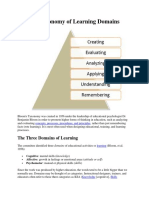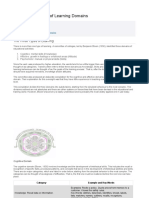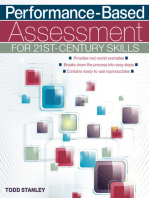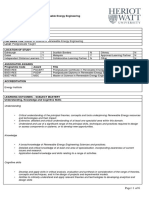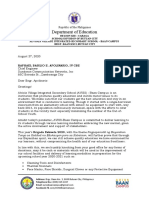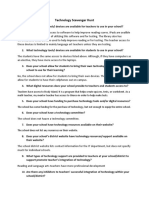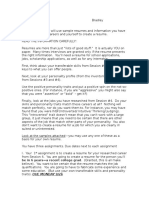0 ratings0% found this document useful (0 votes)
41 viewsBloom's Taxonomy of Learning Domains
Bloom's Taxonomy of Learning Domains
Uploaded by
Fizza RaufBloom's Taxonomy is a framework for classifying educational goals and objectives into levels of complexity and specificity. It was created in 1956 and revised in 2001 to provide a common language for educators to discuss and assess student performance. The taxonomy categorizes learning objectives into Cognitive, Affective, and Psychomotor domains. The Cognitive domain involves knowledge and intellectual skills development, from basic recall or comprehension to more complex analysis, synthesis, and evaluation. Bloom's Taxonomy provides a structure to define learning objectives to promote higher-order thinking skills. It is one of the most widely used frameworks for developing and assessing learning goals and outcomes in education.
Copyright:
© All Rights Reserved
Available Formats
Download as DOCX, PDF, TXT or read online from Scribd
Bloom's Taxonomy of Learning Domains
Bloom's Taxonomy of Learning Domains
Uploaded by
Fizza Rauf0 ratings0% found this document useful (0 votes)
41 views15 pagesBloom's Taxonomy is a framework for classifying educational goals and objectives into levels of complexity and specificity. It was created in 1956 and revised in 2001 to provide a common language for educators to discuss and assess student performance. The taxonomy categorizes learning objectives into Cognitive, Affective, and Psychomotor domains. The Cognitive domain involves knowledge and intellectual skills development, from basic recall or comprehension to more complex analysis, synthesis, and evaluation. Bloom's Taxonomy provides a structure to define learning objectives to promote higher-order thinking skills. It is one of the most widely used frameworks for developing and assessing learning goals and outcomes in education.
Original Description:
language testing
Original Title
Bloom
Copyright
© © All Rights Reserved
Available Formats
DOCX, PDF, TXT or read online from Scribd
Share this document
Did you find this document useful?
Is this content inappropriate?
Bloom's Taxonomy is a framework for classifying educational goals and objectives into levels of complexity and specificity. It was created in 1956 and revised in 2001 to provide a common language for educators to discuss and assess student performance. The taxonomy categorizes learning objectives into Cognitive, Affective, and Psychomotor domains. The Cognitive domain involves knowledge and intellectual skills development, from basic recall or comprehension to more complex analysis, synthesis, and evaluation. Bloom's Taxonomy provides a structure to define learning objectives to promote higher-order thinking skills. It is one of the most widely used frameworks for developing and assessing learning goals and outcomes in education.
Copyright:
© All Rights Reserved
Available Formats
Download as DOCX, PDF, TXT or read online from Scribd
Download as docx, pdf, or txt
0 ratings0% found this document useful (0 votes)
41 views15 pagesBloom's Taxonomy of Learning Domains
Bloom's Taxonomy of Learning Domains
Uploaded by
Fizza RaufBloom's Taxonomy is a framework for classifying educational goals and objectives into levels of complexity and specificity. It was created in 1956 and revised in 2001 to provide a common language for educators to discuss and assess student performance. The taxonomy categorizes learning objectives into Cognitive, Affective, and Psychomotor domains. The Cognitive domain involves knowledge and intellectual skills development, from basic recall or comprehension to more complex analysis, synthesis, and evaluation. Bloom's Taxonomy provides a structure to define learning objectives to promote higher-order thinking skills. It is one of the most widely used frameworks for developing and assessing learning goals and outcomes in education.
Copyright:
© All Rights Reserved
Available Formats
Download as DOCX, PDF, TXT or read online from Scribd
Download as docx, pdf, or txt
You are on page 1of 15
Bl o o m' s Ta x o no my o f Le a r ni ng Do ma i ns
Bloom's Taxonomy was created in 1956 under the leadership of educational
psychologist Dr Benjamin Bloom in order to promote higher forms of
thinking in education, such as analyzing and evaluating, rather than just
remembering facts (rote learning).
T h e T h r e e Ty p e s o f L e a r n i n g
The committee identified three domains of educational activities
or learning (Bloom, 1956):
o Cognitive: mental skills (Knowledge)
o Affective: growth in feelings or emotional areas (Attitude or self)
o Psychomotor: manual or physical skills (Skills)
Since the work was produced by higher education, the words tend to be a
little bigger than we normally use. Domains can be thought of as categories.
Trainers often refer to these three categories as KSA (Knowledge, Skills,
and Attitude). This taxonomy of learning behaviors can be thought of as
the goals of the learning process. That is, after a learning episode, the
learner should have acquired new skills, knowledge, and/or attitudes.
While the committee produced an elaborate compilation for the cognitive
and affective domains, they omitted the psychomotor domain. Their
explanation for this oversight was that they have little experience in
teaching manual skills within the college level (I guess they never thought
to check with their sports or drama departments).
This compilation divides the three domains into subdivisions, starting from
the simplest behavior to the most complex. The divisions outlined are not
absolutes and there are other systems or hierarchies that have been devised
in the educational and training world. However, Bloom's taxonomy is easily
understood and is probably the most widely applied one in use today.
Co g n i t i v e Do ma i n
The cognitive domain involves knowledge and the development of
intellectual skills (Bloom, 1956). This includes the recall or recognition of
specific facts, procedural patterns, and concepts that serve in the
development of intellectual abilities and skills. There are six major
categories, which are listed in order below, starting from the simplest
behavior to the most complex. The categories can be thought of as degrees
of difficulties. That is, the first ones must normally be mastered before the
next ones can take place.
Ta b l e o f t h e Co g n i t i v e Do ma i n
Category Example and Key Words (verbs)
Knowledge: Recall data or
information.
Examples: Recite a policy. Quote prices
from memory to a customer. Know the
safety rules. Define a term.
Key Words: arranges, defines, describes,
identifies, knows, labels, lists, matches,
names, outlines, recalls, recognizes,
reproduces, selects, states.
Comprehension:
Understand the meaning,
translation, interpolation,
and interpretation of
instructions and problems.
State a problem in one's
own words.
Examples: Rewrites the principles of test
writing. Explain in one's own words the
steps for performing a complex task.
Translates an equation into a computer
spreadsheet.
Key Words: comprehends, converts,
defends, distinguishes, estimates, explains,
extends, generalizes, gives an example,
infers, interprets, paraphrases, predicts,
rewrites, summarizes, translates.
Application: Use a concept
in a new situation or
unprompted use of an
abstraction. Applies what
was learned in the
classroom into novel
situations in the work place.
Examples: Use a manual to calculate an
employee's vacation time. Apply laws of
statistics to evaluate the reliability of a
written test.
Key Words: applies, changes, computes,
constructs, demonstrates, discovers,
manipulates, modifies, operates, predicts,
prepares, produces, relates, shows, solves,
uses.
Analysis: Separates
material or concepts into
component parts so that its
organizational structure
may be understood.
Distinguishes between facts
and inferences.
Examples: Troubleshoot a piece of
equipment by using logical deduction.
Recognize logical fallacies in
reasoning. Gathers information from a
department and selects the required tasks for
training.
Key Words: analyzes, breaks down,
compares, contrasts, diagrams, deconstructs,
differentiates, discriminates, distinguishes,
identifies, illustrates, infers, outlines,
relates, selects, separates.
Synthesis: Builds a
structure or pattern from
diverse elements. Put parts
together to form a whole,
with emphasis on creating a
new meaning or structure.
Examples: Write a company operations or
process manual. Design a machine to
perform a specific task. Integrates training
from several sources to solve a problem.
Revises and process to improve the
outcome.
Key Words: categorizes, combines,
compiles, composes, creates, devises,
designs, explains, generates, modifies,
organizes, plans, rearranges, reconstructs,
relates, reorganizes, revises, rewrites,
summarizes, tells, writes.
Evaluation: Make
judgments about the value
of ideas or materials.
Examples: Select the most effective
solution. Hire the most qualified candidate.
Explain and justify a new budget.
Key Words: appraises, compares,
concludes, contrasts, criticizes, critiques,
defends, describes, discriminates, evaluates,
explains, interprets, justifies, relates,
summarizes, supports.
Bl o o m' s Re v i s e d Ta x o n o my
Lorin Anderson, a former student of Bloom, revisited the cognitive domain
in the learning taxonomy in the mid-nineties and made some changes, with
perhaps the two most prominent ones being, 1) changing the names in the
six categories from noun to verb forms, and 2) slightly rearranging them
(Anderson, Krathwohl, Airasian, Cruikshank, Mayer, Pintrich, Raths,
Wittrock, 2000; Pohl, 2000).
This new taxonomy reflects a more active form of thinking and is perhaps
more accurate:
Ta b l e o f Th e Re v i s e d Co g n i t i v e Do ma i n
Category Example and Key Words (verbs)
Remembering: Recall
previous learned
information.
Examples: Recite a policy. Quote prices
from memory to a customer. Knows the
safety rules.
Key Words: defines, describes, identifies,
knows, labels, lists, matches, names,
outlines, recalls, recognizes, reproduces,
selects, states.
Understanding:
Comprehending the
meaning, translation,
interpolation, and
interpretation of
instructions and problems.
State a problem in one's
own words.
Examples: Rewrites the principles of test
writing. Explain in one's own words the steps
for performing a complex task. Translates an
equation into a computer spreadsheet.
Key Words: comprehends, converts,
defends, distinguishes, estimates, explains,
extends, generalizes, gives an example,
infers, interprets, paraphrases, predicts,
rewrites, summarizes, translates.
Applying: Use a concept in
a new situation or
unprompted use of an
abstraction. Applies what
Examples: Use a manual to calculate an
employee's vacation time. Apply laws of
statistics to evaluate the reliability of a
written test.
Key Words: applies, changes, computes,
was learned in the
classroom into novel
situations in the work
place.
constructs, demonstrates, discovers,
manipulates, modifies, operates, predicts,
prepares, produces, relates, shows, solves,
uses.
Analyzing: Separates
material or concepts into
component parts so that its
organizational structure
may be understood.
Distinguishes between facts
and inferences.
Examples: Troubleshoot a piece of
equipment by using logical deduction.
Recognize logical fallacies in
reasoning. Gathers information from a
department and selects the required tasks for
training.
Key Words: analyzes, breaks down,
compares, contrasts, diagrams, deconstructs,
differentiates, discriminates, distinguishes,
identifies, illustrates, infers, outlines, relates,
selects, separates.
Evaluating: Make
judgments about the value
of ideas or materials.
Examples: Select the most effective
solution. Hire the most qualified candidate.
Explain and justify a new budget.
Key Words: appraises, compares, concludes,
contrasts, criticizes, critiques, defends,
describes, discriminates, evaluates, explains,
interprets, justifies, relates, summarizes,
supports.
Creating: Builds a
structure or pattern from
diverse elements. Put parts
together to form a whole,
with emphasis on creating a
new meaning or structure.
Examples: Write a company operations or
process manual. Design a machine to
perform a specific task. Integrates training
from several sources to solve a problem.
Revises and process to improve the outcome.
Key Words: categorizes, combines,
compiles, composes, creates, devises,
designs, explains, generates, modifies,
organizes, plans, rearranges, reconstructs,
relates, reorganizes, revises, rewrites,
summarizes, tells, writes.
Al t e r n a t i v e t o Bl o o m: S t r u c t u r e o f Ob s e r v e d
Le a r n i n g Ou t c o me ( S OLO) Ta x o n o my
While Bloom's Taxonomy has been quite useful in that it has extended
learning from simply remembering to more complex cognitive structures,
such as analyzing and evaluating, newer models have come along. IT has
also become more useful with the revised taxonomy.
However, one model that might prove more useful is the Structure of
Observed Learning Outcome (SOLO) taxonomy. It is a model that describes
levels of increasing complexity in a learner's understanding of subjects
(Biggs, Collis, 1982). It aids both trainers and learners in understanding the
learning process. The model consists of five levels in the order of
understanding:
o Pre-structural - The learner doesn't understood the lesson and uses a much
too simple means of going about itthe learner is unsure about the lesson or
subject.
o Uni-structural - The learner's response only focuses on one relevant aspect
the learner has only a basic concept about the subject.
o Multi-structural - The learner's response focuses on several relevant aspects
but they are treated independentlythe learner has several concepts about
the subject but they are disconnected. Assessment of this level is primarily
quantitative.
o Relational - The different aspects have become integrated into a coherent
wholethe learner has mastered the complexity of the subject by being able
to join all the parts together. This level is what is normally meant by an
adequate understanding of a subject.
o Extended abstract - The previous integrated whole may be conceptualized at
a higher level of abstraction and generalized to a new topic or areathe
learner is now able to create new ideas based on her mastery of the subject.
SOLO not only shows the instructors how the learners are progressing, but
also the learners themselves. This can best be shown by using the square
process (start in the inner square):
Af f e c t i v e Do ma i n
The affective domain (Krathwohl, Bloom, Masia, 1973) includes the
manner in which we deal with things emotionally, such as feelings, values,
appreciation, enthusiasms, motivations, and attitudes. The five major
categories are listed from the simplest behavior to the most complex:
Category Example and Key Words (verbs)
Receiving Phenomena:
Awareness, willingness to
hear, selected attention.
Examples: Listen to others with respect.
Listen for and remember the name of
newly introduced people.
Key Words: asks, chooses, describes,
follows, gives, holds, identifies, locates,
names, points to, selects, sits, erects,
replies, uses.
Responding to Phenomena:
Active participation on the
part of the learners. Attends
and reacts to a particular
phenomenon. Learning
outcomes may emphasize
compliance in responding,
Examples: Participates in class
discussions. Gives a presentation.
Questions new ideals, concepts, models,
etc. in order to fully understand them.
Know the safety rules and practices them.
Key Words: answers, assists, aids,
willingness to respond, or
satisfaction in responding
(motivation).
complies, conforms, discusses, greets,
helps, labels, performs, practices,
presents, reads, recites, reports, selects,
tells, writes.
Valuing: The worth or value a
person attaches to a particular
object, phenomenon, or
behavior. This ranges from
simple acceptance to the more
complex state of
commitment. Valuing is based
on the internalization of a set
of specified values, while
clues to these values are
expressed in the learner's overt
behavior and are often
identifiable.
Examples: Demonstrates belief in the
democratic process. Is sensitive towards
individual and cultural differences (value
diversity). Shows the ability to solve
problems. Proposes a plan to social
improvement and follows through with
commitment. Informs management on
matters that one feels strongly about.
Key Words: completes, demonstrates,
differentiates, explains, follows, forms,
initiates, invites, joins, justifies, proposes,
reads, reports, selects, shares, studies,
works.
Organization: Organizes
values into priorities by
contrasting different values,
resolving conflicts between
them, and creating an unique
value system. The emphasis is
on comparing, relating, and
synthesizing values.
Examples: Recognizes the need for
balance between freedom and responsible
behavior. Accepts responsibility for one's
behavior. Explains the role of systematic
planning in solving problems. Accepts
professional ethical standards. Creates a
life plan in harmony with abilities,
interests, and beliefs. Prioritizes time
effectively to meet the needs of the
organization, family, and self.
Key Words: adheres, alters, arranges,
combines, compares, completes, defends,
explains, formulates, generalizes,
identifies, integrates, modifies, orders,
organizes, prepares, relates, synthesizes.
Internalizing
values(characterization): Has
a value system that controls
their behavior. The behavior is
pervasive, consistent,
predictable, and most
Examples: Shows self-reliance when
working independently. Cooperates in
group activities (displays teamwork).
Uses an objective approach in problem
solving. Displays a professional
commitment to ethical practice on a daily
importantly, characteristic of
the learner. Instructional
objectives are concerned with
the student's general patterns
of adjustment (personal,
social, emotional).
basis. Revises judgments and changes
behavior in light of new evidence. Values
people for what they are, not how they
look.
Key Words: acts, discriminates, displays,
influences, listens, modifies, performs,
practices, proposes, qualifies, questions,
revises, serves, solves, verifies.
Ps y c h o mo t o r Do ma i n
The psychomotor domain (Simpson, 1972) includes physical movement,
coordination, and use of the motor-skill areas. Development of these skills
requires practice and is measured in terms of speed, precision, distance,
procedures, or techniques in execution. The seven major categories are
listed from the simplest behavior to the most complex:
Category Example and Key Words (verbs)
Perception (awareness): The
ability to use sensory cues to
guide motor activity. This
ranges from sensory
stimulation, through cue
selection, to translation.
Examples: Detects non-verbal
communication cues. Estimate where a
ball will land after it is thrown and then
moving to the correct location to catch the
ball. Adjusts heat of stove to correct
temperature by smell and taste of food.
Adjusts the height of the forks on a
forklift by comparing where the forks are
in relation to the pallet.
Key Words: chooses, describes, detects,
differentiates, distinguishes, identifies,
isolates, relates, selects.
Set: Readiness to act. It
includes mental, physical, and
emotional sets. These three
sets are dispositions that
predetermine a person's
response to different
situations (sometimes called
mindsets).
Examples: Knows and acts upon a
sequence of steps in a manufacturing
process. Recognize one's abilities and
limitations. Shows desire to learn a new
process (motivation). NOTE: This
subdivision of Psychomotor is closely
related with the Responding to
phenomena subdivision of the Affective
domain.
Key Words: begins, displays, explains,
moves, proceeds, reacts, shows, states,
volunteers.
Guided Response: The early
stages in learning a complex
skill that includes imitation
and trial and error. Adequacy
of performance is achieved by
practicing.
Examples: Performs a mathematical
equation as demonstrated. Follows
instructions to build a model. Responds
hand-signals of instructor while learning
to operate a forklift.
Key Words: copies, traces, follows, react,
reproduce, responds
Mechanism (basic
proficiency): This is the
intermediate stage in learning
a complex skill. Learned
responses have become
habitual and the movements
can be performed with some
confidence and proficiency.
Examples: Use a personal
computer. Repair a leaking faucet. Drive a
car.
Key Words: assembles, calibrates,
constructs, dismantles, displays, fastens,
fixes, grinds, heats, manipulates,
measures, mends, mixes, organizes,
sketches.
Complex Overt Response
(Expert): The skillful
performance of motor acts
that involve complex
movement
patterns. Proficiency is
indicated by a quick, accurate,
and highly coordinated
performance, requiring a
minimum of energy. This
category includes performing
without hesitation, and
automatic performance. For
example, players are often
utter sounds of satisfaction or
expletives as soon as they hit
a tennis ball or throw a
football, because they can tell
Examples: Maneuvers a car into a tight
parallel parking spot. Operates a computer
quickly and accurately. Displays
competence while playing the piano.
Key Words: assembles, builds, calibrates,
constructs, dismantles, displays, fastens,
fixes, grinds, heats, manipulates,
measures, mends, mixes, organizes,
sketches.
NOTE: The Key Words are the same as
Mechanism, but will have adverbs or
adjectives that indicate that the
performance is quicker, better, more
accurate, etc.
by the feel of the act what the
result will produce.
Adaptation: Skills are well
developed and the individual
can modify movement
patterns to fit special
requirements.
Examples: Responds effectively to
unexpected experiences. Modifies
instruction to meet the needs of the
learners. Perform a task with a machine
that it was not originally intended to do
(machine is not damaged and there is no
danger in performing the new task).
Key Words: adapts, alters, changes,
rearranges, reorganizes, revises, varies.
Origination: Creating new
movement patterns to fit a
particular situation or specific
problem. Learning outcomes
emphasize creativity based
upon highly developed skills.
Examples: Constructs a new theory.
Develops a new and comprehensive
training programming. Creates a new
gymnastic routine.
Key Words: arranges, builds, combines,
composes, constructs, creates, designs,
initiate, makes, originates.
Ot h e r Ps y c h o mo t o r Do ma i n Ta x o n o mi e s
As mentioned earlier, the committee did not produce a compilation for the
psychomotor domain model, but others have. The one discussed above is by
Simpson (1972). There are two other popular versions:
Dave's (1975):
Category Example and Key Words (verbs)
Imitation Observing
and patterning behavior
after someone else.
Performance may be of
low quality.
Examples: Copying a work of art. Performing
a skill while observing a demonstrator.
Key Words: copy, follow, mimic, repeat,
replicate, reproduce, trace
Manipulation Being
able to perform certain
actions by memory or
following instructions.
Examples: Being able to perform a skill on
one's own after taking lessons or reading about
it. Follows instructions to build a model.
Key Words: act, execute, perform
Precision Refining,
becoming more exact.
Performing a skill within
a high degree of precision
Examples: Working and reworking
something, so it will be just right. Perform a
skill or task without assistance. Demonstrate a
task to a beginner.
Key Words: calibrate, demonstrate, master,
perfectionism
Articulation
Coordinating and adapting
a series of actions to
achieve harmony and
internal consistency.
Examples: Combining a series of skills to
produce a video that involves music, drama,
color, sound, etc. Combining a series of skills
or activities to meet a novel requirement.
Key Words: adapt, constructs, creates,
modifies
Naturalization
Mastering a high level
performance until it
become second-nature or
natural, without needing
to think much about it.
Examples: Maneuvers a car into a tight
parallel parking spot. Operates a computer
quickly and accurately. Displays competence
while playing the piano. Michael Jordan
playing basketball or Nancy Lopez hitting a
golf ball.
Key Words: design, development
Harrow's (1972):
Category Example and Key Words (verbs)
Reflex Movements
Reactions that are not
learned, such as a involuntary
reaction
Examples: instinctive response
Key Words: react, respond
Fundamental Movements
Basic movements such as
walking, or grasping.
Examples: perform a simple task
Key Words:grasp and object, throw a ball,
walk
Perceptual Abilities
Response to stimuli such as
visual, auditory, kinesthetic,
or tactile discrimination.
Examples: track a moving object,
recognize a pattern
Key Words: catch a ball, draw or write
Physical Abilities (fitness)
Stamina that must be
Examples: gain strength, run a marathon
developed for further
development such as strength
and agility.
Key Words: agility, endurance, strength
Skilled movements
Advanced learned movements
as one would find in sports or
acting.
Examples: Using an advanced series of
integrated movements, perform a role in a
stage play or play in a set of series in a
sports game.
Key Words: adapt, constructs, creates,
modifies
No discursive
communication Use
effective body language, such
as gestures and facial
expressions.
Examples: Express one's self by using
movements and gestures
Key Words: interpretation
You might also like
- Brides - March 2015 USADocument516 pagesBrides - March 2015 USAFizza Rauf50% (2)
- Step Standard 1 - Part IIDocument5 pagesStep Standard 1 - Part IIapi-449030069No ratings yet
- Bloom's TaxonomyDocument26 pagesBloom's TaxonomyRene John FranciscoNo ratings yet
- Biography of Robert Frost, Poem and Theme of PoemsDocument2 pagesBiography of Robert Frost, Poem and Theme of Poemskpail_1luthraNo ratings yet
- ECE2004 Assignment Sem3'17Document7 pagesECE2004 Assignment Sem3'17yollaineNo ratings yet
- K-12 Performing Arts Task 1: Planning CommentaryDocument8 pagesK-12 Performing Arts Task 1: Planning Commentaryapi-354606259No ratings yet
- Med Academic CatalogDocument143 pagesMed Academic CatalogPat SilveiraNo ratings yet
- University of The Philippines Bachelor of Science in Biology Marc Timothy C. TanDocument9 pagesUniversity of The Philippines Bachelor of Science in Biology Marc Timothy C. TanRhea CelzoNo ratings yet
- Bloom's Taxonomy of Learning DomainsDocument10 pagesBloom's Taxonomy of Learning DomainsEduardo EdwaNo ratings yet
- Domains Bloom's Taxonomy of LearningDocument20 pagesDomains Bloom's Taxonomy of LearningNhil Cabillon QuietaNo ratings yet
- Bloom's Taxonomy of Learning DomainsDocument10 pagesBloom's Taxonomy of Learning DomainsMa. Rhodora MalicdemNo ratings yet
- Week 3 21st CLDocument6 pagesWeek 3 21st CLFlorina Nadorra RamosNo ratings yet
- Bernadette A. Divinagracia: Bloom's TaxonomyDocument9 pagesBernadette A. Divinagracia: Bloom's TaxonomydenizsadayNo ratings yet
- Bloom's Taxonomy of Learning DomainsDocument20 pagesBloom's Taxonomy of Learning DomainsShirley B. MinaNo ratings yet
- Bloom's Taxonomy of Learning DomainsDocument5 pagesBloom's Taxonomy of Learning DomainsHeksi Putri SutrisnoNo ratings yet
- Blooms TaxonomyDocument16 pagesBlooms TaxonomyChristine Navarro-De RoxasNo ratings yet
- Bloom TaxonomyDocument9 pagesBloom Taxonomyapi-256334406100% (2)
- Learning Domains or BloomDocument11 pagesLearning Domains or Bloomakuadalah308No ratings yet
- Bloom's Taxonomy of Learning Domains: Concepts, Processes, Procedures, and PrinciplesDocument6 pagesBloom's Taxonomy of Learning Domains: Concepts, Processes, Procedures, and PrinciplesLen HebronNo ratings yet
- Bloom's Taxonomy of Learning Domains: Concepts, Processes, Procedures, and PrinciplesDocument10 pagesBloom's Taxonomy of Learning Domains: Concepts, Processes, Procedures, and PrinciplesAnonymous G4UABdYMCVNo ratings yet
- Blooms Taxonomy of Learning Domains The PDFDocument12 pagesBlooms Taxonomy of Learning Domains The PDFLin Coloma Viernes WagayenNo ratings yet
- Bloom's Taxonomy of Learning DomainsDocument11 pagesBloom's Taxonomy of Learning Domainsmust dietNo ratings yet
- Bloom's Taxonomy of Learning: Cognitive DomainDocument13 pagesBloom's Taxonomy of Learning: Cognitive Domainmanu_nehaNo ratings yet
- Bloom's Taxonomy of Learning DomainsDocument9 pagesBloom's Taxonomy of Learning Domainsvansick007No ratings yet
- Bloom's Taxonomy of Learning DomainsDocument9 pagesBloom's Taxonomy of Learning DomainsAsif AliNo ratings yet
- Learning Domains or Bloom's Taxonomy: T He Three Types of LearningDocument7 pagesLearning Domains or Bloom's Taxonomy: T He Three Types of LearningRisnantoganto SutarsoNo ratings yet
- Cognitive Domain Bloom TaxonomyDocument2 pagesCognitive Domain Bloom Taxonomypaksu36No ratings yet
- Bloom's Taxonomy of Learning DomainsDocument10 pagesBloom's Taxonomy of Learning DomainsJose JosephNo ratings yet
- Blooms TaxonomyDocument13 pagesBlooms Taxonomyapi-382387880% (5)
- Bloom's Taxonomy of Learning DomainsDocument12 pagesBloom's Taxonomy of Learning DomainsRominaPaolaNo ratings yet
- Teacher Training Program 2018 02-03 July, 2018: The Three Types of LearningDocument8 pagesTeacher Training Program 2018 02-03 July, 2018: The Three Types of LearningUmar HamidNo ratings yet
- Bloom's Taxonomy of Learning DomainsDocument12 pagesBloom's Taxonomy of Learning DomainsFrida Flores RuizNo ratings yet
- Bloom's TaxonomyDocument22 pagesBloom's TaxonomyElvin CornelioNo ratings yet
- Bloom's Taxonomy of Learning DomainsDocument8 pagesBloom's Taxonomy of Learning DomainsSakura MyristicNo ratings yet
- Bloom's TaxonomyDocument8 pagesBloom's TaxonomyNoridah YusofNo ratings yet
- Bloom'S Taxonomy of Learning DomainsDocument27 pagesBloom'S Taxonomy of Learning DomainsKiran KhasaNo ratings yet
- Bloom's TaxonomyDocument19 pagesBloom's TaxonomyZubair KhanNo ratings yet
- Home Site Map About Leadership Training Learning History Knowledge Performance Java Etc. News BlogDocument13 pagesHome Site Map About Leadership Training Learning History Knowledge Performance Java Etc. News BlogJoann Plaza ReforminaNo ratings yet
- Bloom's Taxonomy of Learning DomainsDocument10 pagesBloom's Taxonomy of Learning DomainsKellor NiohNo ratings yet
- Bloom's Taxonomy of Learning Domains: Gubat, SorsogonDocument14 pagesBloom's Taxonomy of Learning Domains: Gubat, Sorsogonleslie Joy EsculturaNo ratings yet
- Bloom's Taxonomy of Learning DomainsDocument5 pagesBloom's Taxonomy of Learning Domainsthanu_2010No ratings yet
- Bloom TaxonomyDocument2 pagesBloom TaxonomyEvelyn TingNo ratings yet
- Bloom's Taxonomy of Learning DomainsDocument15 pagesBloom's Taxonomy of Learning DomainsElma AisyahNo ratings yet
- Bloom's Taxonomy of Learning DomainsDocument9 pagesBloom's Taxonomy of Learning DomainsmalexsastryNo ratings yet
- Bloom's T Axonomy of Learning DomainsDocument11 pagesBloom's T Axonomy of Learning DomainsEzra NolanNo ratings yet
- Chapter 3Document38 pagesChapter 3Kevin MarkNo ratings yet
- Blooms TaxonomyDocument7 pagesBlooms Taxonomyutello100% (2)
- Bloom TaxonomyDocument9 pagesBloom TaxonomyDwiqha QatrunnadaNo ratings yet
- The Cognitive Domain Involves Knowledge and The Development of Intellectual SkillsDocument12 pagesThe Cognitive Domain Involves Knowledge and The Development of Intellectual SkillsChristian Edezon LopezNo ratings yet
- Safari - 23 Oct 2018 at 7:07 AM PDFDocument1 pageSafari - 23 Oct 2018 at 7:07 AM PDFhr187No ratings yet
- Blooms Taxonomy Guide - HandoutDocument3 pagesBlooms Taxonomy Guide - Handoutapi-303124871No ratings yet
- The Three Learning Domains - Cognitive, Affective, PsychomotorDocument19 pagesThe Three Learning Domains - Cognitive, Affective, PsychomotorRicheal BrionesNo ratings yet
- Bloom's Taxonomy: Note That The Top Two Levels Are Essentially Exchanged From The Old To The New VersionDocument17 pagesBloom's Taxonomy: Note That The Top Two Levels Are Essentially Exchanged From The Old To The New VersionNur ZaraNo ratings yet
- Blooms Domains 2Document9 pagesBlooms Domains 2Cherry-Ann C. OlajayNo ratings yet
- Alejandro - WRITTEN ACTIVITY NO. 3 PRINCIPLES OF TEACHINGDocument25 pagesAlejandro - WRITTEN ACTIVITY NO. 3 PRINCIPLES OF TEACHINGAngelica AlejandroNo ratings yet
- Bloom'S Taxonomy of Learning DomainsDocument31 pagesBloom'S Taxonomy of Learning DomainsrometimbaNo ratings yet
- Bloom's TaxonomyDocument6 pagesBloom's TaxonomyJisiamar GeromoNo ratings yet
- Learning Domains or Bloom's Taxonomy: The Three Types of LearningDocument8 pagesLearning Domains or Bloom's Taxonomy: The Three Types of Learningamber ariaNo ratings yet
- All 3 Blooms 2015Document4 pagesAll 3 Blooms 2015Lenie Sang-olanNo ratings yet
- BloomDocument11 pagesBloomTalab_DeepakNo ratings yet
- Bloom's TaxonomyDocument8 pagesBloom's TaxonomyMarissaM.PerezNo ratings yet
- Narrative Writing SlideDocument6 pagesNarrative Writing SlideMPuga TiyagaNo ratings yet
- The Three Types of LearningDocument10 pagesThe Three Types of Learningmary heart baldemoroNo ratings yet
- Bloom's Taxonomy of Learning DomainsDocument16 pagesBloom's Taxonomy of Learning DomainsummerbilalNo ratings yet
- Performance-Based Assessment for 21st-Century SkillsFrom EverandPerformance-Based Assessment for 21st-Century SkillsRating: 4.5 out of 5 stars4.5/5 (14)
- The Models of Skill Acquisition and Expertise Development: A Quick Reference of SummariesFrom EverandThe Models of Skill Acquisition and Expertise Development: A Quick Reference of SummariesNo ratings yet
- Teacher Training Education Programme in Three Muslim Countries-Afghanistan, Iran and PakistanDocument13 pagesTeacher Training Education Programme in Three Muslim Countries-Afghanistan, Iran and PakistanFizza RaufNo ratings yet
- Noun WorksheetDocument1 pageNoun WorksheetFizza RaufNo ratings yet
- Thesis IdeasDocument3 pagesThesis IdeasMuhammad Razif IsmailNo ratings yet
- Teacher Knowledge Matters in Supporting Young ReadersDocument8 pagesTeacher Knowledge Matters in Supporting Young ReadersFizza RaufNo ratings yet
- Preposition of Place Matching ActivityDocument1 pagePreposition of Place Matching ActivityFizza RaufNo ratings yet
- My BugsDocument40 pagesMy BugsFizza RaufNo ratings yet
- CE-2016 Public NoticeDocument1 pageCE-2016 Public NoticeKenneth MillerNo ratings yet
- My Share: A Cooperative, Content-Based Vocabulary ActivityDocument3 pagesMy Share: A Cooperative, Content-Based Vocabulary ActivityFizza RaufNo ratings yet
- An Approach To Esp Materials Evaluation: Paul Mcguinness, Manchester University Med Elt MD 350Document14 pagesAn Approach To Esp Materials Evaluation: Paul Mcguinness, Manchester University Med Elt MD 350Fizza RaufNo ratings yet
- CSS Subjects List: EssayDocument5 pagesCSS Subjects List: EssayFizza RaufNo ratings yet
- Classification and Related LanguagesDocument4 pagesClassification and Related LanguagesFizza RaufNo ratings yet
- The Most Common Tenses in EnglishDocument3 pagesThe Most Common Tenses in EnglishFizza RaufNo ratings yet
- ESP Course DesignDocument7 pagesESP Course DesignFizza Rauf50% (2)
- Syllabus Design and Material Development 2008Document13 pagesSyllabus Design and Material Development 2008Fizza RaufNo ratings yet
- Women's Fitness - February UKDocument168 pagesWomen's Fitness - February UKFizza RaufNo ratings yet
- OnMakeupMagazine PreviewDocument11 pagesOnMakeupMagazine PreviewFizza RaufNo ratings yet
- Women's Running - February 2015 USADocument92 pagesWomen's Running - February 2015 USAFizza RaufNo ratings yet
- General Math Lesson Plan: Grade: 10 Unit: Factor and Remainder Theorem Week: 10 Unit Objective: VocabularyDocument3 pagesGeneral Math Lesson Plan: Grade: 10 Unit: Factor and Remainder Theorem Week: 10 Unit Objective: Vocabularyapi-456913177No ratings yet
- MS CatalogDocument6 pagesMS CatalogAli YousefiNo ratings yet
- Hayden Armistead ResumeDocument2 pagesHayden Armistead Resumeapi-397869256No ratings yet
- Editing Chap 4Document13 pagesEditing Chap 4Vanessa Yvonne GurtizaNo ratings yet
- Mathematics 10: Kauswagan National High SchoolDocument3 pagesMathematics 10: Kauswagan National High SchoolJunard Ceniza100% (5)
- The Features of Academic WritingDocument3 pagesThe Features of Academic WritingDhaeyang Rosales-Tumitay LoreteNo ratings yet
- Curriculum Vitae of Salvador OrozcoDocument3 pagesCurriculum Vitae of Salvador Orozcoapi-380341170No ratings yet
- Bsce3g Header Bpsu 2016Document2 pagesBsce3g Header Bpsu 2016Kristine AnnNo ratings yet
- 11 TTH Themes and MotifsDocument5 pages11 TTH Themes and Motifsapi-276599807No ratings yet
- Action Research ProposalDocument11 pagesAction Research ProposalHenni HerawatiNo ratings yet
- SHR AssignmentDocument5 pagesSHR AssignmentSuriya GopalswamyNo ratings yet
- Department of Education: Republic of The PhilippinesDocument2 pagesDepartment of Education: Republic of The PhilippinesamaezingcielNo ratings yet
- September 17, 2018Document2 pagesSeptember 17, 2018jennelyn malayno100% (2)
- Hidden Curriculum in Schools Its Role in PDFDocument9 pagesHidden Curriculum in Schools Its Role in PDFNidhi DedhiaNo ratings yet
- Technology Scavenger HuntDocument2 pagesTechnology Scavenger Huntapi-431630423No ratings yet
- Deaf Child in Classroom 2012Document6 pagesDeaf Child in Classroom 2012api-336208666No ratings yet
- Personal Profile: Ernesto V. MontenegroDocument2 pagesPersonal Profile: Ernesto V. MontenegroThink-er BelleNo ratings yet
- 717 Technical DrawingDocument5 pages717 Technical DrawingAkatew Haile MebrahtuNo ratings yet
- I.Objectives: Grades 1 To 12 Daily Lesson Log School Grade Level Teacher Learning Area Teaching Dates and Time QuarterDocument3 pagesI.Objectives: Grades 1 To 12 Daily Lesson Log School Grade Level Teacher Learning Area Teaching Dates and Time QuarterRuel Acebron100% (1)
- Hire Me 5 Resume Part 123Document9 pagesHire Me 5 Resume Part 123api-345093725No ratings yet
- Isl CVDocument5 pagesIsl CVapi-321752956No ratings yet
- Lesson Plan AminatolDocument4 pagesLesson Plan AminatolAnthony HarrisNo ratings yet
- 430 Balance BeamDocument19 pages430 Balance Beamapi-326311209No ratings yet
- Final Exam Review Questions ("Big Problems")Document3 pagesFinal Exam Review Questions ("Big Problems")юрий локтионовNo ratings yet

